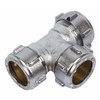Chrome pipe or tube is simply copper pipe with a chrome coating or finish.
This type of pipe is more difficult to use, and often ignored by DIY enthusiasts because the pipe has a chrome coating and does not bend well. You will find that the coating of chrome sometimes flakes or cracks off if the procedure of chrome plating is not good quality.
This type of finished pipe work is more commonly used in high quality surface plumbing work used in bathrooms/kitchens where it is more visually pleasing than copper or painted copper which tends to "yellow" in sunlight or in constantly warm conditions.
A gradual bending can be accomplished with correct bending tools, such as bending springs which are placed inside the length of pipe to be bent, this protects the length of pipe from creasing and if bent slowly keeps control of the bending action and gives a continuous smooth bend. The best way to bend pipe of any kind is by using the appropriate tools and copper pipe bending can be seen at the link.
Compression joints finished in the same quality chrome finish are used for more immediate turns in the pipe work.
The required pipe lengths will need to be worked out and pre-cut taking into account the size and lengths of the compressing joint i.e. Straight connector joint, 90° joint or 60° join for turns in the pipe work if you are working to a set lay out plan.
Always use non serrated gripping spanners or grippers with these type of fittings otherwise the chrome effect can be damaged,(you can cover the chrome nut you are tightening with a thin cloth just to make sure no marking occurs).
Push fit / Speed fit fittings can also be used with this type of piping but you must remember to remove the chrome finish this is because within the fitting there is a stainless steel grip ring which is not strong enough to grip chrome and your seal will not work or continue to hold over a period of time.

Using chrome pipe in your plumbing
Cutting chrome pipe can be accomplished in many ways; the best method is by using a good hack saw with the pipe held firmly in a griping device. Once again make sure the pipe is protected against tooth marks from a vice or grips. You might think that a pipe slice would work.
It will but the hard surface of the chrome pipe will blunt your pipe slice very quickly and become an expensive procedure. See our project on cutting copper pipes Remember that cutting metal will leave sharp ends especially with chrome pipe.
Chrome pipe can be soldered together with solder fittings but you will have to insure that the chrome plating has been removed to guarantee a bond. You can achieve this with the use of sand paper or emery cloth. You will need to finish off with wire wool to clean up the finished surface before you solder.
Chrome pipe work should only really be used for surface or where it is visible installation, once the pipe work is not visible i.e. below floor level or hidden by boxing you should use plastic push fit or copper due to the cost.
As always with projects that create dust, debris and have sharp components DIY Doctor always recommends the use of gloves, dust masks and eye protection.

